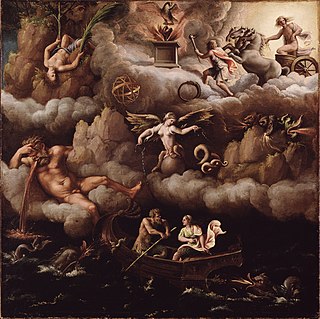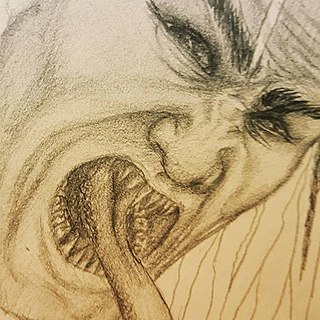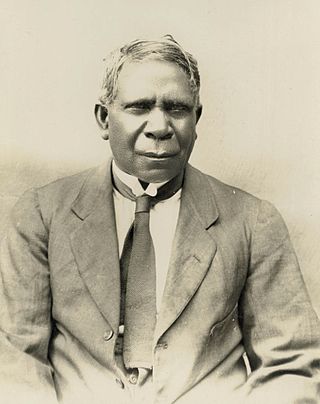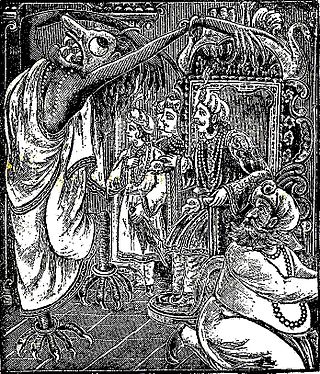Related Research Articles

The bunyip is a creature from the aboriginal mythology of southeastern Australia, said to lurk in swamps, billabongs, creeks, riverbeds, and waterholes.

A vampire is a mythical creature that subsists by feeding on the vital essence of the living. In European folklore, vampires are undead humanoid creatures that often visited loved ones and caused mischief or deaths in the neighbourhoods which they inhabited while they were alive. They wore shrouds and were often described as bloated and of ruddy or dark countenance, markedly different from today's gaunt, pale vampire which dates from the early 19th century. Vampiric entities have been recorded in cultures around the world; the term vampire was popularized in Western Europe after reports of an 18th-century mass hysteria of a pre-existing folk belief in Southeastern and Eastern Europe that in some cases resulted in corpses being staked and people being accused of vampirism. Local variants in Southeastern Europe were also known by different names, such as shtriga in Albania, vrykolakas in Greece and strigoi in Romania, cognate to Italian 'Strega', meaning Witch.

A monster is a type of fictional creature found in horror, fantasy, science fiction, folklore, mythology and religion. Monsters are very often depicted as dangerous and aggressive, with a strange or grotesque appearance that causes terror and fear, often in humans. Monsters usually resemble bizarre, deformed, otherworldly and/or mutated animals or entirely unique creatures of varying sizes, but may also take a human form, such as mutants, ghosts, spirits, zombies, or cannibals, among other things. They may or may not have supernatural powers, but are usually capable of killing or causing some form of destruction, threatening the social or moral order of the human world in the process.

The kallikantzaros is a malevolent creature in Southeast European and Anatolian folklore. Stories about the kallikantzaros or its equivalents can typically be found in Greece, Bulgaria, Turkey, Serbia, Albania, Bosnia, and Cyprus. Kallikantzaroi are believed to dwell underground but come to the surface during the twelve days of Christmas, from 25 December to 6 January.

Aswang is an umbrella term for various shape-shifting evil creatures in Filipino folklore, such as vampires, ghouls, witches, viscera suckers, and transforming human-beast hybrids. The aswang is the subject of a wide variety of myths, stories, arts, and films, as it is well known throughout the Philippines. Spanish colonists noted that the aswang was the most feared among the mythical creatures of the Philippines, even in the 16th century. Although with no specific motive other than harming others, their behavior can be interpreted as an inversion of the traditional Filipino's values. The aswang is especially popular in southern parts of Luzon, and some parts of Mindanao and Visayas, especially the Visayan province of Capiz.

David Ngunaitponi, known as David Unaipon, was an Aboriginal Australian preacher, inventor, and author. A Ngarrindjeri man, his contribution to Australian society helped to break many stereotypes of Aboriginal people, and he is featured on the Australian $50 note in commemoration of his work. He was the son of preacher and writer James Unaipon.

The Ngarrindjeri people are the traditional Aboriginal Australian people of the lower Murray River, eastern Fleurieu Peninsula, and the Coorong of the southern-central area of the state of South Australia. The term Ngarrindjeri means "belonging to men", and refers to a "tribal constellation". The Ngarrindjeri actually comprised several distinct if closely related tribal groups, including the Jarildekald, Tanganekald, Meintangk and Ramindjeri, who began to form a unified cultural bloc after remnants of each separate community congregated at Raukkan, South Australia.

The Jindyworobak Movement was an Australian literary movement of the 1930s and 1940s whose white members, mostly poets, sought to contribute to a uniquely Australian culture through the integration of Indigenous Australian subjects, language and mythology. The movement's stated aim was to "free Australian art from whatever alien influences trammel it" and create works based on an engagement with the Australian landscape and an "understanding of Australia's history and traditions, primeval, colonial and modern".

Yowie is one of several names for an Australian folklore entity that is reputed to live in the Outback. The creature has its roots in Aboriginal oral history. In parts of Queensland, they are known as quinkin, and as joogabinna, in parts of New South Wales they are called Ghindaring, jurrawarra, myngawin, puttikan, doolaga, gulaga and thoolagal. Other names include yahweh, noocoonah, wawee, pangkarlangu, jimbra and tjangara. Yowie-type creatures are common in Aboriginal Australian legends, particularly in the eastern Australian states.
Yara may refer to:

William Ramsay Smith, frequently referred to as Ramsay Smith, was a Scottish physician, educator, naturalist, anthropologist and civil servant, who worked in South Australia after moving there at the age of about 37 in 1896. He was initially appointed as a pathologist at the Royal Adelaide Hospital and was later appointed to other roles, including that of city coroner in Adelaide, but his legacy has been marred by allegations of misuse of human remains. He made a study of Aboriginal Australians, and sent body parts to Edinburgh University's anthropological collection. He published a number of books and articles in scientific journals, and in 1930 published a work under his own name which was later found to be the work of Ngarrindjeri Elder David Unaipon.

Colombian folklore are beliefs, customs and cultural traditions in Colombia.

Legends of vampires have existed for millennia; cultures such as the Mesopotamians, Hebrews, ancient Greeks, and Romans had tales of demonic entities and blood-drinking spirits which are considered precursors to modern vampires. Despite the occurrence of vampire-like creatures in these ancient civilizations, the folklore for the entity known today as the vampire originates almost exclusively from early 18th-century Central Europe, particularly Transylvania as verbal traditions of many ethnic groups of the region were recorded and published. In most cases, vampires are revenants of evil beings, suicide victims, or witches, but can also be created by a malevolent spirit possessing a corpse or a living person being bitten by a vampire themselves. Belief in such legends became so rife that in some areas it caused mass hysteria and even public executions of people believed to be vampires.

Ghosts are an important and integral part of the folklore of the socio-cultural fabric of the geographical and ethno-linguistic region of Bengal which presently consists of Bangladesh and the Indian states of West Bengal and Tripura. Bengali folktales and Bengali cultural identity are intertwined in such a way that ghosts depicted reflect the culture it sets in. Fairy tales, both old and new, often use the concept of ghosts. References to ghosts are often found in modern-day Bengali literature, cinema, radio and television media. There are also alleged haunted sites in the region. The common word for ghosts in Bengali is bhoot or bhut. This word has an alternative meaning: 'past' in Bengali. Also, the word Pret is used in Bengali to mean ghost. In Bengal, ghosts are believed to be the unsatisfied spirits of human beings who cannot find peace after death or the souls of people who died in unnatural or abnormal circumstances like murders, suicides or accidents. Non-human animals can also turn into ghosts after their death. But they are often associated with good luck and wealth in Bangladesh.

The drop bear is a hoax in contemporary Australian folklore featuring a predatory, carnivorous version of the koala. This imaginary animal is commonly spoken about in tall tales designed to scare tourists. While koalas are typically docile herbivores, drop bears are described as unusually large and vicious marsupials that inhabit treetops and attack unsuspecting people that walk beneath them by dropping onto their heads from above.

Indigenous Australian literature is the fiction, plays, poems, essays and other works authored by Aboriginal and Torres Strait Islander people of Australia.
Garkain is a legendary creature in Australian Aboriginal mythology said to haunt the dense jungle along the Liverpool River in the Northern Territory, Australia. Should an unwary traveller enter his domain, Garkain swoops down from the trees on his leathery wings and envelops them. It is a story parents tell to their children to tell them to not use physical violence as a way to solve problems.
References
- 1 2 3 W. Ramsay Smith (1932). Myths and Legends of the Australian Aboriginals. Farrar & Rinehart. p. 342. 2003 reprint
- 1 2 Slingerland, Edward; Collard, Mark (1 May 2011). Creating Consilience: Integrating the Sciences and the Humanities. Oxford University Press. ISBN 978-0-19-979448-5.
- ↑ Unaipon, David (2001). Legendary tales of the Australian aborigines. Carlton, Vic.: Melbourne University Press. ISBN 9780522849059.
- ↑ Melton, J. Gordon. The Vampire Book: The Encyclopedia of the Undead. Omnigraphics, Incorporated; 1999. ISBN 9781578590711